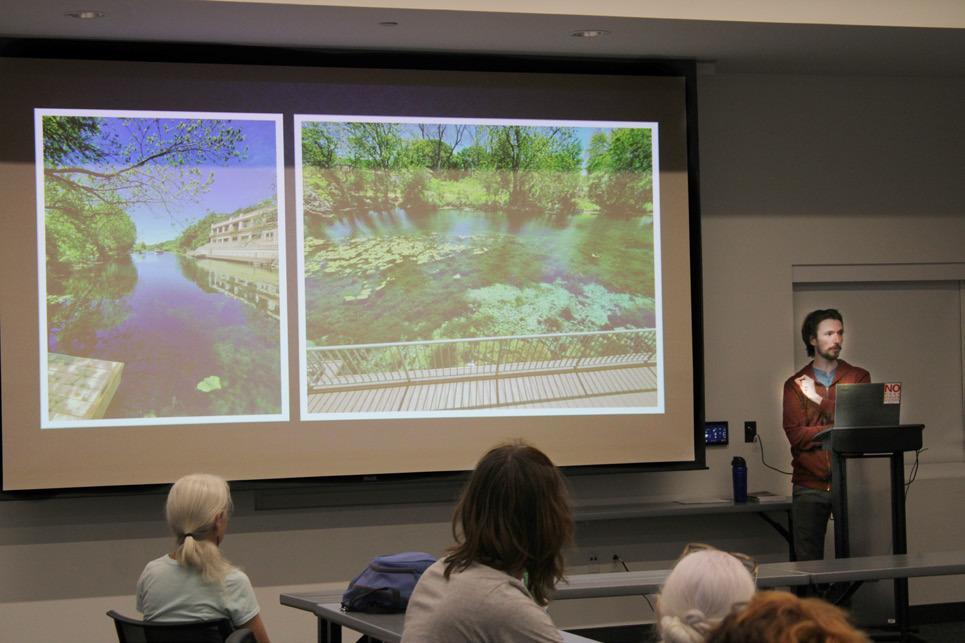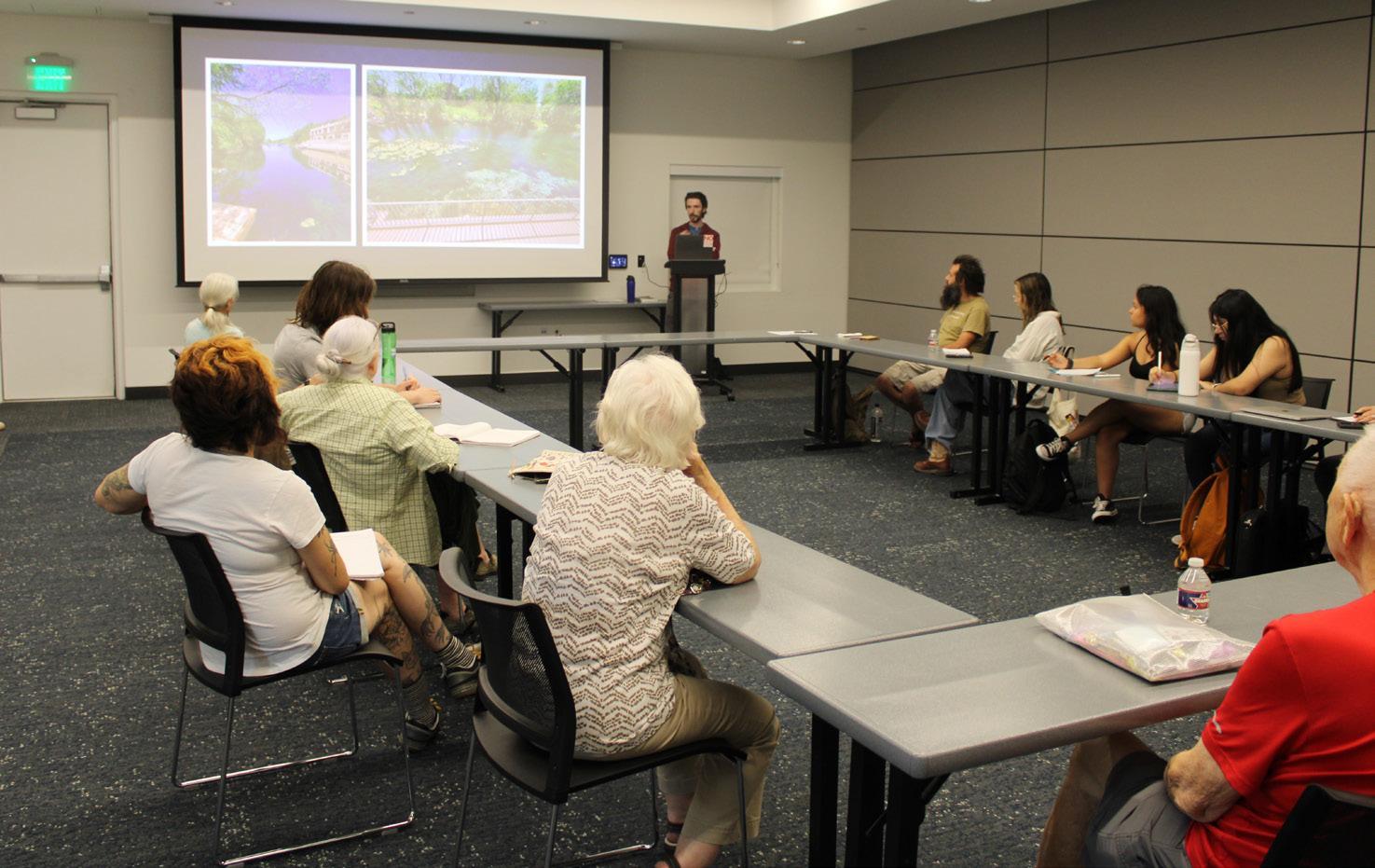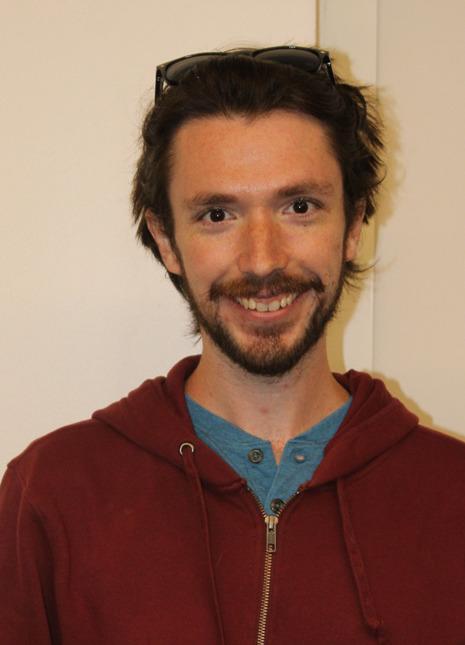
Jeff Gessas, TXST Philosophy Department lecturer, lectures to a room full of people at the library.
Daily Record photos by Shannon West

Jeff Gessas, TXST Philosophy Department lecturer, discussed the history of Spring Lake and the engaged ecology viewpoint for protection of the springs, which are currently flowing at their slowest rate, during the Philosophy Dialogues at the San Marcos Public Library.
Daily Record photos by Shannon West

Jeff Gessas
Professor discusses history of Spring Lake and engaged ecology
Spring Lake, Aquarena Springs and the San Marcos Springs are all names for a cherished asset in the community – the headwaters of the San Marcos River. It has been a theme park in the past and is now under special protections due to the endangered species located there. It is not open to the public to swim in at their leisure, but it can still be snorkeled in or paddled on in small numbers through tours operated by the Meadows Center for Water and the Environment. The springs have a rich history and are a central part of the creation story and the home to the Coahuiltecan people for thousands of years. In the conclusion of the Philosophy Dialogue Lecture Series hosted at the San Marcos Public Library and spearheaded by Jo Ann Carson, a Texas State University Department of Philosophy senior lecturer, the final discussion involved Spring Lake. Jeff Gessas, TXST Department of Philosophy lecturer, explained the history, the need to protect this valuable resource and the engaged ecology and environmental justice implications associated with the springs.
“Environmental Justice as a framework … is a way of reconceptualizing environmental issues as inherently welded to other social issues such as race, class, gender, human health, education, housing, transportation, civil rights, energy and environmental access,” Gessas said. “[An] engaged Ecology approach recognizes place as an event, whereby the intrinsic link between humans and the other than human world is nested. In short, the environment is where we live, work and play.”
Gessas said that the springs have long been a site of meeting and exchange among Indigenous people. The White Shaman Panel, located at the border of Texas and Mexico, is a rock painting that depicts the springs at Spring Lake and was made about 2,000 to 4,000 years ago, according to the Witte Museum website — another example of the rich history of these springs.
“I would like to honor and respect diverse indigenous peoples connected to this territory on which we are gathered that have stewarded this land for generations,” Gessas said. “I’d also like to pay respect to elders both past and present and to the land and the waters themselves.”
Gessas also explained the more recent history. Edward Burleson created the dam that made Spring Lake, which inundated the springs and many indigenous artifacts. Spring Lake caught the attention of Arthur Birch Rogers, who made the area into a theme park called Aquarena Springs and built the hotel located there to house visitors, which is now the location of the Meadows Center.
“It had an underwater theater; It had a building submerged under the water. These spring waters are artisanal springs, which means that the waters are extremely clear and clean consistently year round. You don't have seasonal rotations of temperatures in the lake because it's spring water. And so as a result, there's a consistent sort of flora and fauna ecosystem, which allows for a great deal of underwater visibility,” Gessas said, adding that this is where people could watch the mermaid shows, which also had underwater clowns and Ralph the swimming pig. “And that's why, if you don't know, there's random mermaid statues all over San Marcos. It's an acknowledgment of that history.”
Gessas said that the profitability of Aquarena Springs declined in the 80s, and TXST bought it in 1994. Shortly after, it was discovered that Spring Lake was the home to eight different endemic endangered species, which are “so particular to their environment that they live very little other places.” He said three of the more well-known of those species are the Texas Blind Salamander, the San Marcos Salamander and Texas Wild Rice.
“The Meadows Center was created with an emphasis on habitat reclamation, environmental preservation, environmental education and research,” Gessas said, adding that the Meadows Center kept the glass bottom boats, which were originally part of the theme park. “They've been developing, and this is something that the engaged ecology initiative is developing, some mindfulness and field environmental philosophy activities in which you actually get out there and do some field philosophy and engage with the space and try to forge a relationship for yourself.”
Gessas said the springs have the lowest flow rate recorded with very few still flowing. He said that there are different regulations for surface water and groundwater; surface water is better protected. The surface water at Spring Lake is composed of groundwater from the Edwards Aquifer.
“Aquifers are characterized as groundwater rather than surface water and are subject to little regulation and few laws, which govern drawing water. And [with] the absence of regulation, water use is commonly dictated by an erroneous perception of abundance within the reality of scarcity,” Gessas said. “And the reason it's slowing down is two-fold: development in the recharge zones … and too many straws drawing out of the aquifers.”
Gessas discussed the low flow rate and its negative impact on species both in and out of the water, ecotourism and people with a connection to the springs such as locals and the Miakan Garza Band of the Coahuiltecan people.
“Environmental justice in the Texas Hill Country confronts justice for a vulnerable ecoregion — a constellation of different populations across social status, class, race, species, land access and infrastructural preparedness,” Gessas said. “Most people in the Hill Country, in my experience this is increasingly true, have no meaningful relationship with the spring or their aquifers. If people have no relationship with the environment, they'll have little incentive to participate in any type of conservation efforts.”
Gessas said there are two sides of the line. On one side, which is visible, there’s the science of conservation, nature as a form of entertainment and natural resources to be consumed or preserved. He said on the invisible side of the line, there is indigenous history with the springs, relationships built with the springs, kinship with nature and a recognition of relationality and interdependence.
“Engaged ecology from an environmental justice perspective emphasizes the development and remembrance of relations between human beings and the other than human world,” Gessas said. “The environment is where we live, we work and we play.”
Develop a relationship with the springs by participating in tours by the Meadows Center, which can be found here meadowscenter. txst.edu/explorespringlake.











